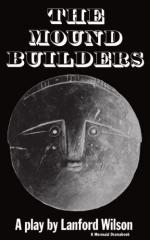The grand mound.
It is situated on the Rainy River, about 20 miles from the head of Rainy River. It stands on a point of land where the Missachappa or Bowstring River and the Rainy River join. There is a dense forest covering the river bank where the mound is found. The owner of the land has made a small clearing, which now shows the mound to some extent to one standing on the deck of a steamer passing on the river. The distance back from the water’s edge is about 50 yards. The mound strikes you with great surprise as your eye first catches it. Its crest is covered with lofty trees, which overtop the surrounding forest. These thriving trees, elm, soft maple, basswood and poplar, 60 or 70 feet high now thrust their root tendrils deep into the aforetime softened mould. A foot or more of a mass of decayed leaves and other vegetable matter encases the mound. The brushy surface of the mound has been cleared by the owner, and the thicket formerly upon it removed. The circumference of one fine poplar was found to be 4 feet 10 inches; of another tree, 5 feet 6 inches, but the largest had lately fallen. Around the stump the last measured seven feet. The mound is eliptical at the base. The longest diameter, that is from east to west, the same direction as the course of the river, is 117 feet. The corresponding shorter diameter from north to south is 90 feet. The circumference of the mound is consequently 325 feet. The highest point of the mound is 45 feet above the surrounding level of the earth. As to height the mound does not compare unfavorably with the celebrated mound at Miamisburg, Ohio, known as one of the class of “observation mounds,” which is 68 feet high and 852 feet around the base. In addition to its purpose of sepulture, everything goes to show that the “Grand Mound” of Rainy River was for observation as well.
The excavation.
Two former attempts had been made to open this mound. One of these had been made in the top, and the large skull before you was then obtained. A more extensive effort was that made in 1883, by Mr. E. McColl, Indian agent, Mr. Crowe, H. B. Co. officer of Fort Frances, and a party of men. Their plan was to run a tunnel from north to south through the base of the mound. They had penetrated some ten or fifteen feet, found some articles of interest, and had then given up the undertaking. Having employed a number of men, settlers in the neighborhood, I determined to continue the tunnel for a certain distance through the mound, all the way if indications were favorable, and then to pierce the mound from the top. The men in two parties went industriously to work on the opposite sides, working toward each other, making a tunnel about eight feet in diameter. The earth though originally soft soil had become so hard that it was necessary to use a pick axe to loosen it for the spade. A number of skeletons were found on the south side,




